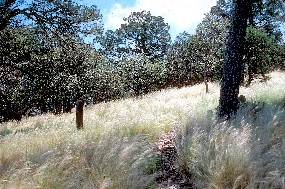 |
| NPS/Big Bend National Park | | There are large patches of stipa grass in the Chisos Mountains. |
 |
Grasses in the desert?
Sure enough, even though Big Bend is mostly a desert environment there are a few large expanses of grassland and even some open savanna type areas in the park. Some early settlers to the Big Bend suggest much of the park was once a grassland. For example in J. O. Langford's book "Big Bend: A homesteader's story" he describes the Big Bend lush with grasses and "(I)t stood knee-deep to a horse everywhere".
Langford was most likely referring to the grasslands north of Big Bend National Park in the Marathon basin or just east of the Davis mountains. However, even logs from earlier visits to the Big Bend by Spaniards in the 17th century reported the area to be lush with grasses.
Nonetheless, today much of the old grasslands are since gone. Without them many species have struggled to survive in the park. Animals like pronghorn, prairie dogs, wild turkey, Mexican gray wolf, and bighorn sheep were more common before the ranching and settlement in the Big Bend country. Wether or not it was hunting by the ranchers, competition between species for resources, or overuse of the water sources that ended their persistence in the area we may never know.
We do know that grasslands were once part of the park and we are involved in a process to reintroduce this ecosystem to the park. This process will be a challenge with ever increasing numbers of introduced species, the problems associated with disturbed land, and drought which is typical in this desert environment.
| 





